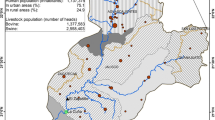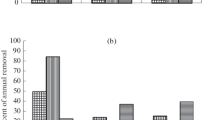Abstract
Method for estimating the maximum allowable nutrient runoff from the territories of the Baltic Sea basin, which takes into account the heterogeneity of the catchment area has been drawn up. The method includes the integration of background components of runoff.
Similar content being viewed by others
References
Gidrometeorologiya i gidrohimiya morej SSSR. Tom III. Baltijskoe more. Vyp. 1. Gidrometeorologicheskie usloviya (Hydrometheorology and Hydrochemistry of the USSR sees. V. III. Baltic Sea. Issue. 1. Hydrometheorological Conditions), Ed.: Tersieva, F. S., St. Petersburg: Hydrometheoisdat, 1992.
Eutrophication in the Baltic Sea — An integrated thematic assessment of the effects of nutrient enrichment in the Baltic Sea region, Balt. Sea Environ. Proc., 2009, no. 115B, p. 149.
Savchuk, O. P. and Gutshabash, E. Sh., in Proekt «Baltika». Problemy issledovaniya i matematicheskogo modelirovaniya eko sistemy Baltijskogo morya. Vyp. 4. Osnovnye tendentsii evolyutsii ekosistemy (Project «Baltics», Problems of Study and Mathematucal Modelling of the Baltic Sea Ecosystem. Issue. 4. Main Tendencies of Ecosystem Evolution), Eds. Davidjan I. N., Aitsama A. M., Leningrad: Hydrometheoisdat, 1989, pp. 125–144.
HELCOM Baltic Sea Action Plan, HELCOM Ministerial Meeting, Krakow, Poland, 2007, p. 101.
HELCOM BSAP EUTRO EXP/2007, Expert Meeting for the Eutrophication Segment under the HELCOM Baltic Sea Action Plan, Helsinki, Finland, 2007, p. 33.
The fourth Baltic Sea Pollution Load Compilation (PLC-4), Balt. Sea Environ. Proc., 2004, no 93, p. 189.
Author information
Authors and Affiliations
Additional information
Elena Vladimirovna Stepanova, Cand. Sc. (Geogr.), Senior Lecturer, Department of the Environment Chemistry, Russian State Hydrometeorologic University. Scientific areas of focus: hydrochemistry, geochemistry, eutrophication and chemical pollution of natural waters.
Grigorii Tevelevich Frumin, Dr. Sc. (Chem.), Prof., Department of Ecology, Russian State Hydrometeorologic University. Scientifi c areas of focus: toxicology, eutrophication and chemical pollution of natural waters, risk assessment.
Original Russian Text © E.V. Stepanova, G.T. Frumin, 2010, published in Ekologicheskaya Khimiya, 2010, Vol. 19, no. 1, pp. 31–37.
Rights and permissions
About this article
Cite this article
Stepanova, E.V., Frumin, G.T. Geoecological justification of the ultimate levels of nutrients export from the territories of the Baltic Sea basin. Russ J Gen Chem 80, 2731–2737 (2010). https://doi.org/10.1134/S1070363210130062
Received:
Published:
Issue Date:
DOI: https://doi.org/10.1134/S1070363210130062




